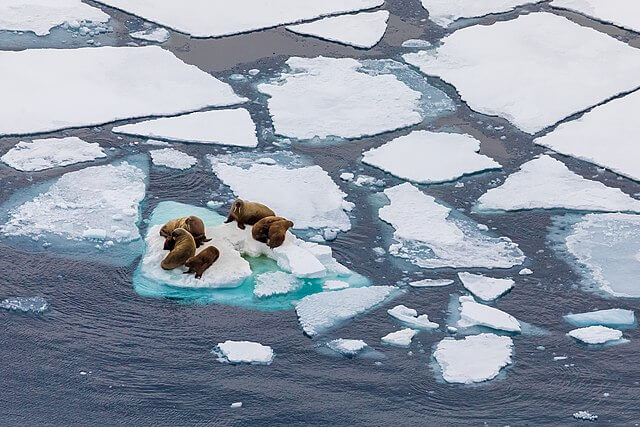
‘Extreme situation’: Antarctic sea ice reaches a record low.
Scientists warn that the loss of glaciers and ice caps, which would significantly raise sea levels, is prevented by sea ice.
Scientists have stated that they have “never seen such an extreme situation before” as the area of sea ice surrounding Antarctica has decreased to a record low. Before the summer melting season ends this year, it is expected that the ice extent will shrink even further.
Sea ice in the Arctic is clearly affected by the climate crisis, as evidenced by records dating back to 1979. Since Antarctic sea ice changes so much from year to year, it has been harder to see how global warming is affecting it.
However, “remarkable” losses of Antarctic sea ice over the past six years may indicate that the climate crisis is finally showing up in the observations due to record levels of heat in the ocean and related changes in weather patterns.
Antarctic ice had already caused scientists great concern. In 2014, climate models predicted that the continent’s enormous West Antarctic Ice Sheet (WAIS) was doomed to collapse as a result of the levels of global warming that had already occurred.
Researchers warned that the increasing loss of sea ice exposes ice sheets and their glaciers to waves that accelerate their breakdown and melting. According to a recent study, a global temperature rise of just 1 degree Celsius would cause the WAIS to gradually collapse, leading to a four-meter rise in sea level.
“I have never seen such an extreme, ice-free situation here before,” said Prof Karsten Gohl, from the Helmholtz Centre for Polar and Marine Research in the Alfred Wegener Institute, Germany, and who first visited the region in 1994.
Gohl, on board the research vessel Polarstern in Antarctica, said: “The continental shelf, an area the size of Germany, is now completely ice-free. It is troubling to consider how quickly this change has taken place.”
Prof Christian Haas, also at the Helmholtz Centre, said: “The rapid decline in sea ice over the past six years is quite remarkable, since the ice cover hardly changed at all in the 35 years before.”
Additionally, scientists from the United States’ National Snow and Ice Data Center assert that a new record low has been established. According to them, Antarctic sea ice extent decreased to 1.91 million square kilometers on February 13, falling short of the previous record set on February 25, 2022.
Sea ice melts away in the Antarctic summer before starting to grow again as autumn arrives. “In past years, the annual minimum has occurred between 18 February and 3 March, so further decline is expected,” the NSIDC researchers said. “Much of the Antarctic coast is ice free. Earlier studies have linked low sea ice cover with wave-induced stresses on the floating ice shelves that hem the continent, leading to break up of weaker areas.”
According to the German researchers, the “intense melting” could have been caused by air temperatures that were 1.5 degrees Celsius higher than the long-term average to the west and east of the Antarctic peninsula. Additionally, strong westerly winds have increased sea ice retreat. According to the researchers, the outcome is ““intensified melting of ice shelves, an essential aspect of future global sea-level rise.”
They claimed that Antarctica’s dramatic changes can also be seen in historical records. In the Antarctic summer of 125 years ago, the Belgian research vessel Belgica was imprisoned for more than a year in massive pack ice in exactly the same region as the Polarstern vessel that is currently sailing in ice-free waters.
Prof Carlos Moffat, at the University of Delaware, US, and recently returned from a research cruise in the Southern Ocean, told Inside Climate News: “The extraordinary change we’ve seen this year is dramatic. Even as somebody who’s been looking at these changing systems for a few decades, I was taken aback by what I saw.”
——————————————————————————
At Natural World Fund, we are passionate about stopping the decline in our wildlife.
The declines in our wildlife is shocking and frightening. Without much more support, many of the animals we know and love will continue in their declines towards extinction.
When you help to restore a patch of degraded land through rewilding to forests, meadows, or wetlands, you have a massive impact on the biodiversity at a local level. You give animals a home and food that they otherwise would not have had, and it has a positive snowball effect for the food chain.
We are convinced that this is much better for the UK than growing lots of fast-growing coniferous trees, solely to remove carbon, that don’t actually help our animals to thrive.
This is why we stand for restoring nature in the UK through responsible rewilding. For us, it is the right thing to do. Let’s do what’s right for nature!
Support our work today at https://naturalworldfund.com/ and join in the solution!

